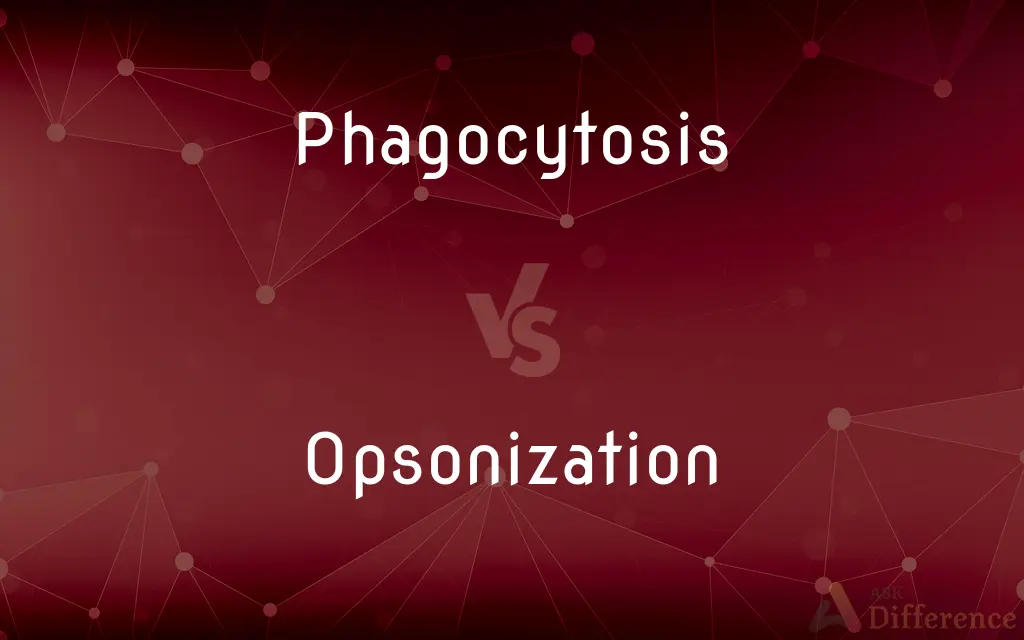Phagocytosis vs. Opsonization — What's the Difference?
By Tayyaba Rehman & Urooj Arif — Published on February 9, 2024
Phagocytosis is the process where cells engulf and digest particles, while opsonization is the coating of these particles with antibodies to make them more recognizable for phagocytosis.

Difference Between Phagocytosis and Opsonization
Table of Contents
ADVERTISEMENT
Key Differences
Phagocytosis is a crucial cellular process where cells, mainly phagocytes, ingest and eliminate pathogens or debris. On the other hand, opsonization is a preparatory process where pathogens are marked with opsonins, making them identifiable targets for phagocytosis. Both mechanisms are essential in the body's defense system, with phagocytosis directly eliminating threats and opsonization facilitating this elimination by marking targets.
During phagocytosis, the cell membrane extends around the target particle, eventually engulfing it. In contrast, opsonization involves the binding of opsonins, such as antibodies or complement proteins, to the surface of pathogens. Although phagocytosis and opsonization are distinct processes, they are interconnected, with opsonization significantly enhancing the efficiency of phagocytosis by making targets more 'palatable' to phagocytes.
Phagocytosis is performed by specialized cells like macrophages and neutrophils, which are key players in the innate immune response. Conversely, opsonization is a mechanism that bridges innate and adaptive immunity, with antibodies (adaptive immunity) or complement proteins (innate immunity) acting as opsonins. While phagocytosis represents a physical cellular response to pathogens, opsonization represents a biochemical tagging system.
The success of phagocytosis in clearing pathogens can be significantly influenced by the effectiveness of opsonization. Without opsonization, pathogens may evade phagocytosis due to their surface properties or by resisting engulfment. Opsonization not only marks these pathogens but also provides 'handles' for phagocyte receptors, thereby facilitating phagocytosis.
In summary, phagocytosis and opsonization are complementary processes in the immune system. Phagocytosis involves the direct ingestion and destruction of pathogens by immune cells, while opsonization marks these pathogens, enhancing their recognition and uptake by phagocytes. Both processes are vital for the efficient functioning of the immune response, with opsonization tailoring the immune system's response to specific pathogens and phagocytosis executing the final clearance.
ADVERTISEMENT
Comparison Chart
Definition
The cellular process of engulfing and digesting particles.
The process of marking pathogens with opsonins to enhance recognition by phagocytes.
Primary Function
Directly eliminates pathogens or debris through ingestion.
Marks and prepares pathogens for recognition and elimination by phagocytes.
Involved Cells
Performed by phagocytes (e.g., macrophages, neutrophils).
Involves opsonins like antibodies or complement proteins.
Role in Immune Response
A physical cellular response representing a key aspect of innate immunity.
Bridges innate and adaptive immunity by marking pathogens for phagocytosis.
Dependency
Can occur without opsonization, but efficiency may be reduced.
Facilitates and enhances the process of phagocytosis.
Compare with Definitions
Phagocytosis
Phagocytosis is the cellular process of engulfing and digesting solid particles.
Macrophages undergo phagocytosis to remove cellular debris from the bloodstream.
Opsonization
Opsonization is the process of marking pathogens with opsonins to enhance phagocytosis.
The opsonization of bacteria by antibodies makes them easily recognizable for destruction by macrophages.
Phagocytosis
Phagocytosis is a defense mechanism where cells ingest harmful pathogens.
During an infection, phagocytosis acts rapidly to engulf invading bacteria.
Opsonization
Opsonization involves the binding of complement proteins or antibodies to pathogens.
After opsonization, pathogens become more susceptible to being engulfed by immune cells.
Phagocytosis
Phagocytosis is part of the cell’s innate immune response.
Phagocytosis by white blood cells is crucial for clearing pathogens in the initial stages of infection.
Opsonization
Opsonization enhances the efficiency of the immune response against pathogens.
The process of opsonization ensures a swift and targeted immune response to infection.
Phagocytosis
Phagocytosis is a selective process, targeting specific particles for engulfment.
Neutrophils exhibit phagocytosis by specifically targeting and ingesting foreign particles.
Opsonization
Opsonization is crucial for identifying and neutralizing evasive pathogens.
Through opsonization, even pathogens with protective coats are marked and made vulnerable to immune cells.
Phagocytosis
Phagocytosis involves the formation of a vesicle, known as a phagosome, inside the cell.
The phagosome formed during phagocytosis contains enzymes to break down the ingested material.
Opsonization
Opsonization serves as a bridge between innate and adaptive immunity.
Opsonization with specific antibodies marks a pathogen for targeted destruction by the immune system.
Phagocytosis
The engulfing and destruction of particulate matter, such as a bacterium, by a cell.
Opsonization
To make (bacteria or other pathogens) more susceptible to the action of phagocytes.
Phagocytosis
A form of endocytosis in which a cell incorporates a particle by extending pseudopodia and drawing the particle into a vacuole of its cytoplasm.
Opsonization
(immunology) The process or result of opsonizing
Phagocytosis
Process in which phagocytes engulf and digest microorganisms and cellular debris; an important defense against infection
Opsonization
Process whereby opsonins make an invading microorganism more susceptible to phagocytosis
Common Curiosities
What is opsonization?
Opsonization is the process of marking pathogens with molecules known as opsonins to enhance their recognition and ingestion by phagocytes.
What cells are primarily responsible for phagocytosis?
Cells like macrophages, neutrophils, and dendritic cells are primarily responsible for phagocytosis.
Is opsonization a part of innate or adaptive immunity?
Opsonization acts as a bridge between innate and adaptive immunity by involving elements of both systems.
How are phagocytosis and opsonization related?
Opsonization marks pathogens for recognition, making them easier targets for phagocytosis, which is the actual ingestion and digestion of these marked pathogens.
Does opsonization directly kill pathogens?
No, opsonization itself does not kill pathogens; it marks them for destruction by phagocytes through phagocytosis.
Can phagocytosis occur without opsonization?
Yes, phagocytosis can occur without opsonization, but opsonization enhances the efficiency and specificity of phagocytosis.
What is phagocytosis?
Phagocytosis is the process where cells engulf and digest particles, such as pathogens or cellular debris.
What are common opsonins used in opsonization?
Common opsonins include antibodies, complement proteins, and certain plasma proteins.
Can opsonization enhance vaccine efficacy?
Yes, vaccines can be designed to induce opsonin production, thereby enhancing the immune system's ability to recognize and eliminate the pathogen.
Can a pathogen be opsonized by more than one type of opsonin?
Yes, pathogens can be coated with multiple types of opsonins, enhancing their recognition by phagocytes.
How do phagocytes recognize opsonized pathogens?
Phagocytes have receptors on their surface that specifically bind to opsonins coating the pathogens.
How does phagocytosis contribute to antigen presentation?
After phagocytosis, parts of the digested pathogens (antigens) can be presented on the cell surface of phagocytes to initiate specific immune responses.
Are there any diseases associated with defects in phagocytosis or opsonization?
Yes, deficiencies in phagocytosis or opsonization can lead to recurrent infections and are seen in certain immune disorders.
How does the body regulate phagocytosis and opsonization?
The body regulates these processes through various signals and receptors that ensure balance and prevent damage to healthy cells.
Is phagocytosis active in all body tissues?
Phagocytosis primarily occurs in tissues where phagocytes are present, such as the bloodstream, lymph nodes, and spleen.
Share Your Discovery

Previous Comparison
Soya Milk vs. Normal Milk
Next Comparison
1AC in Indian Railway vs. 2AC in Indian RailwayAuthor Spotlight
Written by
Tayyaba RehmanTayyaba Rehman is a distinguished writer, currently serving as a primary contributor to askdifference.com. As a researcher in semantics and etymology, Tayyaba's passion for the complexity of languages and their distinctions has found a perfect home on the platform. Tayyaba delves into the intricacies of language, distinguishing between commonly confused words and phrases, thereby providing clarity for readers worldwide.
Co-written by
Urooj ArifUrooj is a skilled content writer at Ask Difference, known for her exceptional ability to simplify complex topics into engaging and informative content. With a passion for research and a flair for clear, concise writing, she consistently delivers articles that resonate with our diverse audience.
















































